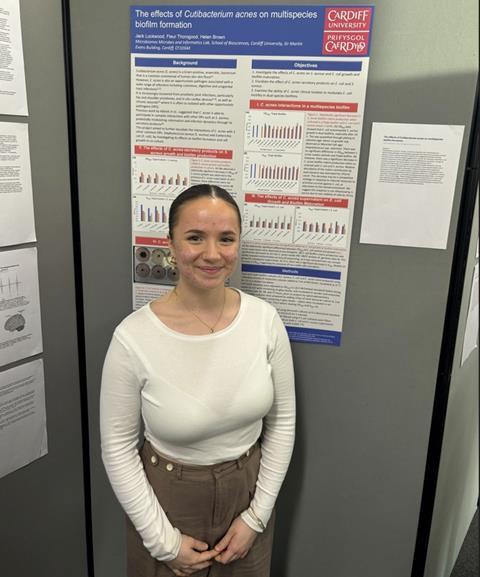Fleur Thorogood (20), from Cheltenham, reveals what happened during her Applied Microbiology International-sponsored Summer Placement at Cardiff University investigating Cutibacterium acnes host adaptation with respect to biofilms.

A Biological Sciences undergrad at Cardiff University, she did her placement in in the MMI labs within the School of Biosciences, working alongside Dr Helen Brown and a team of undergraduates.
She says:
During my placement, I have investigated the interactions of Staphylococcus aureus, Escherichia coli and C. acnes within dual and triple biofilms. This has given insight into the growth and biofilm production by each species and how these factors are affected when they are competing in a biofilm.
We also developed techniques that would allow for the co-incubation of mammalian host cells and C. acnes. To do this we developed a multi-well insert system which allowed us to simultaneously maintain the necessary anaerobic conditions for C. acnes, while also allowing aerobic growth of the cell lines.
Another key element of my project was researching and attempting to develop a selective agar for C. acnes so that we could ensure that we could selectively isolate the C. acnes from mixed species cultures, ensuring there were no potential contaminants that may impact the validity of our data.
Real-world aims
Not only is there an obvious link to the role of the skin microbiome in skin disease, but C.acnes can adapt to a vast range of body sites - including chronic wounds, prostate and prosthetic joint infections.
This means that the role of C. acnes in wider infections and disease cannot be underestimated. Through understanding how different phylotypes of C. acnes can adapt to the host and its interaction with other bacterial species, we aim to provide insight into the communication that may underpin key mechanisms such as antibiotic resistance.
What has surprised me most is the vast differences between phylotypes of C.acnes and the extent that they can adapt to their environment. For example, phylotypes IB and II can be a protective commensal within the skin microbiome whilst simultaneously being pathogenic within prosthetic joint infections.
Additionally, by examining the biofilm production of S. aureus and E. coli in the presence of C. acnes supernatants, we found that C. acnes has phylotypic variation within the biofilms of S. aureus and E. coli for up to 24 hours, after which this difference becomes less significant. Therefore, it is interesting to see the complex links between the development of the biofilm over time and the specificity of how different species interact.
What this means
We hope that by demonstrating the vast phylotypic differences within C. acnes as well as its interactions with both E. coli and S. aureus, we can provide a basis that can allow for further research into whether inter-species communication may vary across different infection sites and if this is also related to the antibiotic resistance found within these infections.
Once I have completed this project, I will return to finish my final year of my undergrad. From here I hope to return to research within a microbiology lab - however, I am keen to keep my options open so that I can gain a wide range of experience, both inside and outside of the lab.
As part of the project we also attended a poster conference to present our findings to a range of scientists from many fields.
This was informative and helped to aid our future directions both in my undergraduate degree and the project as a whole.
Least favourite job in the lab?
My time in the lab has taught me many invaluable skills, including the importance of maintenance and preparation of equipment, consumables and reagents in the effective running of projects.
Despite knowing its importance, it sometimes can be frustrating to spend so much time racking pipette tips and ensuring that the team has enough media prepared to complete experiments.
Dr Helen Brown says:
We all know how beneficial research experience is for students, but it’s also amazingly beneficial for supervisors. Alongside giving me experience of grant writing, supervision and project management, the work summer research students carried out while I was a postdoc was integral to my first last-author paper.
Now as a lecturer, my summer students help me generate pilot data for grants and test out new research ideas. The optimization work Fleur completed this year gives my research students starting in September a head start. Work in the summer has highlighted which experiments should be the priority and hinted at the areas we’ll need to optimise further.
READ MORE: Scientists put Mars DNA sampling protocols to the test with help from AMI grant







No comments yet